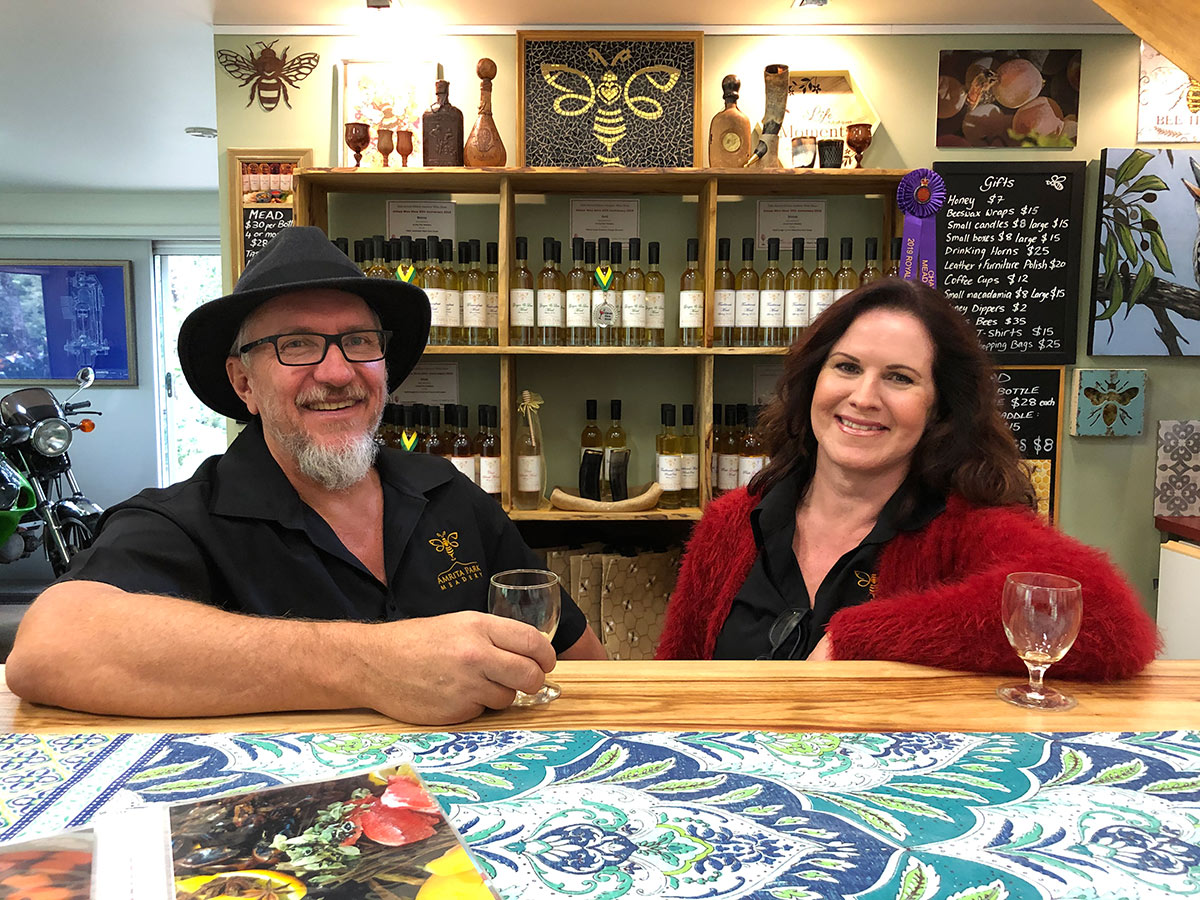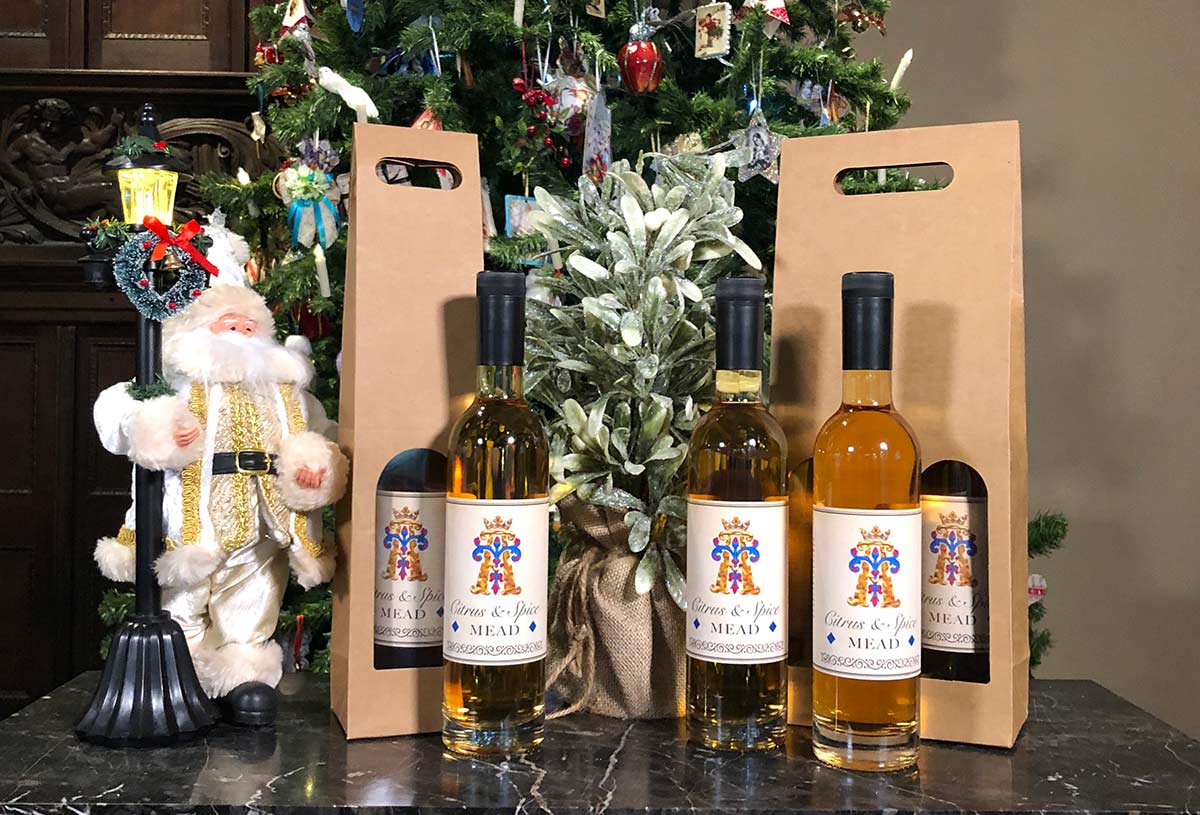In July 2020, we launched a specially made Abbey label Mead to our supporters through a wonderful collaboration with Amrita Park Meadery. Production for these custom batches began 12 months earlier at their Meadery in the Noosa Hinterland, and we planned for distribution at the Abbey Medieval Festival. When the Festival was called off, we shifted to sell the bottles from our new online shop. They sold out in just 5 days! It provided much needed momentum in finding new ways to support our Museum.
Driven by this success, we began to create additional products for the The Abbey Shop. We were excited to collaborate on a new bottle for the Holiday season. We love supporting small business, especially those of which are very passionate about what they do. Mead is the oldest alcohol to be made and consumed by people, and today it is enjoying a revival. That said, the basic facts this fanastic beverage still remain absent from the majority of people today.
In this blog we chat with Andy Coates, owner of Amrita Park Meadery, and discuss some fundamentals of mead! Enjoy!

Owners Andy Coates and Nicola Cleaver in the tasting room.
“Due to the awareness of the benefits of bees as pollinators and the fact Mead production does not cause the clearing of land for other crops, there are strong environmental reasons for the Mead resurgence.”
Why is Mead enjoying a revival?
Andy Coates: Mead is the oldest alcoholic beverage. It went out of fashion due to the high cost of honey as a fermentable sugar source and the emergence of other cheaper fermentable sugar sources due to the expansion of agriculture namely grains for ales, grapes for wines and apples for ciders. The other disadvantage of Mead was the extended aging process that was usually required for a tasty product.
Due to the awareness of the benefits of bees as pollinators and the fact, production does not cause the clearing of land for other crops, there are strong environmental reasons for the resurgence. Couple this with better scientific understanding of the fermentation process that has allowed modern techniques in yeast health management during fermentation to shorten the Mead making process to months instead of years. It is easy to see why this amazing, tasty and flexible drink has had a massive increase in popularity. It is a trend that is set to continue.
What are the ways to drink Mead?
Chilled or on ice- some varieties go very well chilled or served poured over ice. A little of the melting ice can help meld and mellow more intense flavours which can improve the drinking experience – this is especially true with fruity varieties in summer time.
Neat – There are a lot of traditionalists that enjoy Mead at room temperature only. Some varieties are best served this way, this includes higher ABV (Alcohol by Volume) and sweeter dessert style Meads.
Warmed – Enjoying it warmed is very popular with spiced flavours, particularly in winter time. A warmed Spiced Mead can release a lot of the amazing aromatics of the spices used and can lift the experience to new heights.
What kind of drinking vessels should you drink it from?
Drinking horns are very popular at festivals and events however they can be a bit impractical as they need a holster or stand to put down.
We usually use a ISO XL5 220 ml wine glass, which are the same as used for tasting wine and used in wine competitions. We find the size and shape ideal for most Mead.
There are also plenty of options for goblets in many sizes and shapes made from clay, pewter or even timber. There are no strict rules and it should be enjoyed from something you enjoy drinking from.
“We usually use a ISO XL5 220 ml wine glass for drinking our Mead, these are the same as used for tasting wine and used in wine competitions. We find the size and shape ideal for most Mead.”

Nestled among the trees is the Amrita Park tasting room!
How do you warm Mead?
Again there are a few options, some like to use a double boiler on a stove top to gently warm it. Some like to warm it in a metal cup or container on or near a fireplace. An open pot near an open fire can have the advantage of infusing some smokiness into it which can be very good.
What food does it pair with?
There are so many types and styles that there is a Mead that can pair with pretty much any food. Citrus and Spiced tend to go well with Pork dishes. Ginger & Lime, Pink Grapefruit and other more acidic Mead pairs very well with seafood and spicy Asian dishes. Janoticaba and Traditional flavours go great with lamb, beef and more hearty dishes. Most of our Mead tends to go well with spicy food.
All of our Mead definitely are amazing with Charcuterie and cheeses of all type. Being in the range of semi sweet to semi dry, it does not usually pair well with desserts and sweet food as it does not have enough residual sweetness to carry it off and the flavours will be drowned out by the sweeter food.
Which Mead is your favourite?
I am a sucker for a chilled fruity Mead over ice.
How long will Mead last?
This depends mostly on how the Mead is looked after post purchase. Once open it can oxidise a little however this is not always a bad thing as a little oxidation can add a certain depth or complexity. We would recommend keeping the bottles in a cool and constant temperature or in the fridge. Higher ABV mead is intrinsically more stable. For long term ageing we recommend keeping it in a constant cool and dark environment and be treated the same as for cellaring a good wine.
However, we live in Queensland and this is not the ideal climate for keeping Mead long term, so we suggest to enjoy it instead of keeping it. You can avoid disappointment if the Mead gets heat affected and there are always new and changing flavours becoming available.

Andy with the first bottle of Abbey 2020 Mead!
“We only use locally sourced honey and fruit in our Mead. This is in no way restrictive for us as we have a massive range of traditional and exotic produce on offer close by.”
How do you decide what fruits and spices to add?
We have a philosophy similar to the slow food mantra of good, clean, fair. We only use locally sourced honey and fruit in our Mead. This is in no way restrictive for us as we have a massive range of traditional and exotic produce on offer close by. We conduct experimental trials with fruit, including matching particular honey, with particular fruit and trialling various yeast and techniques until we have a good recipe that showcases both the honey and fruit and spices used. The limit is only our imagination.
Does Mead improve with age?
Most Mead will improve to various degrees with age, however it has to be looked after correctly and kept away from high temperatures or large temperature fluctuations as this can change or destroy proteins in the Mead.
If we were having a degustation dinner, where would you serve Mead?
We would talk with the chef and recommend a few different types to enhance the menu. As each type is so different, it gives the opportunity to place it alongside various dishes in the same sitting. We usually avoid pairing with sweet entrees or desserts though.
We have also had our Mead used in the actual meals as ingredients for high end degustation menus, for example as part of a dressing in a spicy salad and for poaching pears in a high end dessert.
Some final Mead Maker recommendations?
Join and/or follow the below on FB and their websites, there is a wealth of information for Mead Makers including, files sections with recipes and hints/tips, online help to all your questions, Mead Maker Meet ups and a great new Association that is growing the Mead Industry for professionals as well as amateur Mead Makers
- Mead Australia web site and FB page https://www.meadaustralia.com.au/ https://www.facebook.com/Meadaustralia
- Australian Mead makers FB page https://www.facebook.com/groups/AustralianMeadMakers/about
- Amrita Park Meadery FB and website https://www.amritaparkmeadery.com.au/ https://www.facebook.com/thebestmead


